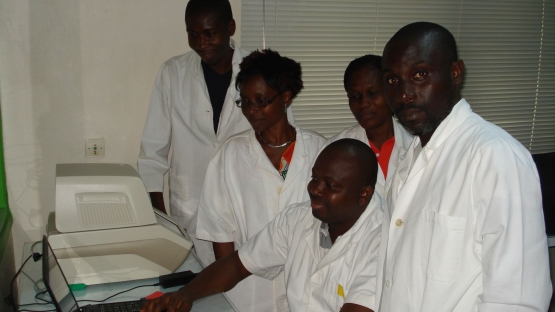Following the recent outbreak of avian flu in Cote d’Ivoire, the IAEA – through its partnership with the Food and Agriculture Organization of the United Nations (FAO) – is helping West African countries in the early and accurate detection of the virus using nuclear-derived techniques.
The present avian flu outbreak is caused by the highly pathogenic avian influenza H5N1 (HPAI-H5N1), which is an infectious zoonotic disease: not only is it deadly for birds, particularly poultry and fowl, but it can also spread to humans.
“For National Authorities to receive an early indication or warning of possible zoonotic disease outbreaks is vital,” said Michel Warnau, Section Head in the IAEA’s Division for Africa. “These diseases come in waves, and we need to be alert. In recent years, over 100 million chickens have been killed to control, mitigate or prevent avian flu. West Africa is facing another epidemic avian flu threat.”
The control of avian flu is a top priority in the fight for global food security and public health. In May, the World Organisation for Animal Health (OIE) announced that Cote d’Ivoire confirmed an outbreak of the HPAI-H5N1 strain among backyard birds in the central town of Bouake. IAEA experts took part in the confirmation of the outbreak, by assisting the national veterinary laboratory in the use of the nuclear-derived, reverse transcription polymerase chain reaction (RT-PCR) platform technique for the identification of animals infected with the HPAI-H5N1 avian flu virus. The immediate concern that this virus could pass onto poultry and humans led to a swift response from the IAEA, Warnau said.
According to WHO "about 75% of the new diseases that have affected humans over the past 10 years have been caused by pathogens originating from an animal or from products of animal origin." Warnau further added that "with increased trade and expanding human populations, we need to be particularly vigilant against diseases that can be transmitted from livestock and wild animals to humans.”
In Cote d’Ivoire and beyond
In supporting the efforts to rapidly identify outbreaks of HPAI-H5N1 in Burkina Faso, Cote d’Ivoire, Ghana, Niger and Nigeria, the IAEA, jointly with the FAO, is playing a critical role in helping to detect the avian flu.
Several West African countries rely on poultry as a source of food and income, and the implications of these outbreaks in the region are alarming for the public health system.
“More than 50 per cent of humans infected with the HPAI-H5N1 strain virus die but luckily transmission to humans is relatively rare,” said Gerrit Viljoen, Head of the Animal Production and Health Section at the Joint FAO/IAEA Division of Nuclear Techniques in Food and Agriculture.
The IAEA is training scientists in veterinary diagnostic laboratories in West Africa and providing them with a toolbox of kits to facilitate rapid diagnosis and characterization of the precise avian flu strain virus. The diagnostic toolbox delivered to the laboratories is based on the RT-PCR platform technique, which amplifies a single copy or a few copies of a specific DNA sequence to millions of copies that can then be easily detected and identified.
Minimizing impact through early detection
“To achieve the high level of diagnostic specificity and sensitivity needed to detect and characterize a pathogen, we require nuclear and nuclear derived technologies. These technologies and their applications are essential tools in any diagnostic veterinary laboratory,” said Viljoen. “We need to detect the harmful pathogens before the onset of the disease.”
From among the 16 avian flu varieties, the OIE has classified the type A influenza as the most deadly. Its subtypes H5, H7 and, recently, H9 are the most contagious and can have critical pathogenic implications if not controlled in a timely manner.
“The Joint FAO/IAEA Division has been the frontrunner in the development, evaluation and validation of the RT-PCR technique, a nuclear-derived molecular diagnostic technology that allows detecting diseases such as the Ebola Virus Disease, foot-and-mouth disease, African swine fever, rinderpest and peste des petits ruminats (PPR). The method enables a rapid and accurate detection of the pathogens, in order to pinpoint the exact type of the disease within a few hours,” said Viljoen. The technique will play a crucial role in the global campaign against PPR, a close relative to rinderpest. In the global rinderpest eradication campaign, another nuclear-derived technique, enzyme-linked immunosorbent assay (ELISA) was used, leading to worldwide eradication in 2011.
The IAEA, through its technical cooperation programme, and with the support of its Joint FAO/IAEA Division has been supporting more than 32 African countries in training to develop skills and acquire the necessary equipment to use the DNA amplification platform for the diagnosis of animal and zoonotic diseases. A refresher training course for West African laboratories will be held later this year to enhance laboratory emergency preparedness in connection with the HPAI-H5N1 virus.
In March 2015, the IAEA’s Board of Governors approved a technical cooperation project to strengthen preparedness in the African region for the early detection of zoonotic diseases in livestock and wildlife. The project will help disseminate knowledge, strengthen skills and expertise and build capacities essential for the early recognition of risks of zoonotic disease outbreaks, and to prepare them to take measures to avoid or mitigate possible future outbreaks among humans.
With increased trade and expanding human populations, we need to be particularly vigilant against diseases that can be transmitted from livestock and wild animals to humans.




